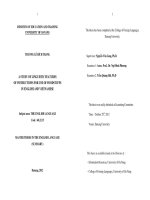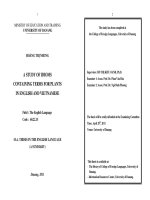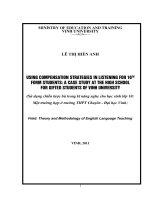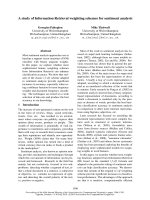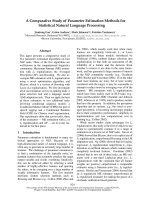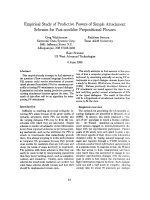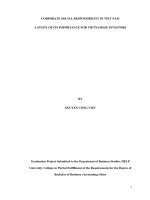Study of wireless communication technology for internet of things applications
Bạn đang xem bản rút gọn của tài liệu. Xem và tải ngay bản đầy đủ của tài liệu tại đây (1.15 MB, 82 trang )
Hanoi University of Science and Technology
MASTER THESIS
STUDY OF WIRELESS COMMUNICATION
TECHNOLOGY FOR INTERNET OF THINGS
APPLICATIONS
SARA NHACUONGUE LAICE
Major: Telecommunication Engineering
Supervisor: Dr. Phung Thi Kieu Ha
Institute: School of Electronics and Telecommunications, Hanoi University of
Science and Technology
HANOI, December 2020
1
CERTIFICATION OF THESIS CORRECTION
Full name of author of thesis: Sara Da Purificaỗóo Nhacuongue Laice
Thesis topics: STUDY OF WIRELESS COMMUNICATION TECHNOLOGY FOR
INTERNET OF THINGS APPLICATIONS
Major: Telecommunication Engineering
Student ID number: CA190273
The author, the scientific instructor and the chairman of the jury certify that the author
made corrections and additions to the thesis according to the comments and requests of
the Jury dated .................... ................ ......... …………with the following contents:
…………………………………………………………………………………………………… ..
………………………… ………………………………………………………………………… ..
…………………………………………………… ……………………………………………… ..
……………………………………………………………………………… …………………… ..
…………………………………………………………………………………………………… ..
…………………………………………………………………………………………………… ..
………………………… ………………………………………………………… ..
Hanoi, Jan 12, 2021
Supervisor
Thesis author
Chairman of Jury
2
ACKNOWLEDGEMENT
To God, who always lit up my walk.
To my Supervisor Dr. Phung Kieu Ha, for the encouragement and guidance given during
the training.
To all the professors of School of Electronics and Telecommunications for their
knowledge sharing, availability, and attention throughout the training process.
To all my family and friends for their support and collaboration.
3
SUMMARY
The concept of IoT was first proposed by Kevin Ashton in 1999, he referred to IoT as
connected objects uniquely identifiable with radio frequency identification (RFID)
technology. IoT is generally defined as a “dynamic global network infrastructure with
self-configuring capabilities based on communication standards and protocols”. Physical
and virtual things in an IoT have their own identities and attributes which can use
intelligent interfaces and be integrated as an information network. In a simplified way,
IoT can be treated as a set of connected devices that are uniquely identifiable. The IoT
system requires that "things" on the network are connected to each other, because things
can move and need to interact with others in real-time. It is also possible to develop
several applications based on it, of which only a few applications are currently deployed.
Examples of the Internet of Things range from smartly connected homes to wearables
and health services. IoT is gradually becoming a part of every aspect of our lives. Soon,
there will be smarter apps for smarter homes and offices, smarter transportation systems,
smarter hospitals, smarter businesses, and factories. Internet of Things applications not
only increase our comfort but also give us more control to simplify work routines and
personal tasks. Therefore, for this to happen, it is necessary to establish communication
between IoT devices and the Internet, and this is done using IoT communication
technologies and protocols depending on the application, factors such as reach, data
requirements, security and energy demands, and duration of the battery which will dictate
the choice of technologies/protocols or some form of a combination of technologies.
The objective of this dissertation is to study the IoT, its essential components, and the
technologies and protocols to realize several IoT systems/applications. Later, the work
focuses on the study of Smart Home, a perspective specific to IoT-based systems, and the
design and production of a prototype of a controlled lighting device connected to the
Internet, a proof of concept of a Smart lighting control system.
4
The smart home is a term that refers to modern homes that have appliances, lighting,
and/or electronic devices that can be controlled remotely by the owner, usually through a
mobile app. Smart home-enabled devices can also operate in conjunction with other
devices in the house and communicate information to other smart devices. At Smart
Home, all devices are controlled by a home automation master controller, called a smart
home hub. It combines all the different apps into a single smart home app that can be
controlled remotely by owners.
Some smart home systems can be created from scratch, for example, using a Raspberry Pi
or other prototyping board. To demonstrate an understanding of the topics covered in the
dissertation we will develop and design a proof-of-concept prototype for remote
monitoring and control of home appliances. We also discussed the performance of the
system by doing some tests on our implemented circuit.
This text will consist of the following contents: Chapter I discusses the introduction of
IoT and Chapter II describes the technologies, protocols, architecture, and challenges of
IoT. Chapter III presents the description of Smart Homes in detail and mentions the
future of Smart Homes. In chapter IV, we will show the design and construction of a
prototype to demonstrate the monitoring and remote control of home appliances. We also
discussed the performance of the system by carrying out some tests on our implemented
circuit and, finally, the last section presents the conclusions of our work.
5
Table of Contents
CHAPTER 1.
INTRODUCTION ............................................................................................................ 1
1.1
Introduction of IoT (Internet of Things) ....................................................................................... 1
1.2
Concept and History of IoT .......................................................................................................... 2
1.2.1
Concept ................................................................................................................................. 2
1.2.2
History................................................................................................................................... 3
1.3
Applications of IoT ....................................................................................................................... 4
1.4
Overview of thesis work ............................................................................................................... 7
1.5
Conclusion .................................................................................................................................... 7
CHAPTER 2.
IoT TECHNOLOGIES AND PROTOCOLS.................................................................... 9
2.1
Basic Components of IoT System................................................................................................. 9
2.2
IoT Architecture .......................................................................................................................... 12
2.2.1
The 3 Layer Architecture .................................................................................................... 12
2.2.2
The 5 Layer Architecture .................................................................................................... 13
2.2.3
Service-Oriented Architecture for IoT ................................................................................ 14
2.3
Communication technologies of IoT........................................................................................... 17
2.4
Application Protocols in IoT ....................................................................................................... 25
2.4.1
Application Layer Protocols ............................................................................................... 26
2.4.2
Service Discovery Protocols ............................................................................................... 27
2.4.3
Network Infrastructure Protocols ........................................................................................ 28
2.5
Challenges of IoT ........................................................................................................................ 29
CHAPTER 3.
IoT IN SMART HOME .................................................................................................. 34
3.1
Smart Home ................................................................................................................................ 34
3.2
Benefits and Challenges of Smart Home .................................................................................... 35
6
3.2.1
Benefits ............................................................................................................................... 35
3.2.2
Challenges ........................................................................................................................... 36
3.3
Smart Home Technologies .......................................................................................................... 36
3.3.1
Comparison between Smart Home Transmission Technologies......................................... 40
3.4
Examples of smart home applications......................................................................................... 44
3.5
How smart homes work/smart home implementation ................................................................ 45
3.6
Smart buildings ........................................................................................................................... 46
3.7
Analyses of Smart Home products in Energy saving.................................................................. 47
3.8
Future of Smart Home................................................................................................................. 51
3.9
Conclusion .................................................................................................................................. 53
CHAPTER 4.
4.1
SMART HOME DEMONSTRATION ........................................................................... 54
Project Overview ........................................................................................................................ 54
4.1.1
System Diagram .................................................................................................................. 54
4.1.2
Hardware diagram ............................................................................................................... 54
4.1.3
Firmware Design ................................................................................................................. 61
4.1.4
Pseudocode of firmware...................................................................................................... 61
4.1.5
Arduino IDE ........................................................................................................................ 62
4.1.6
Blynk ................................................................................................................................... 63
4.1.7
Application design .............................................................................................................. 64
4.2
Testing......................................................................................................................................... 68
4.3
Conclusion .................................................................................................................................. 69
CONCLUSION ........................................................................................................................................... 70
REFERENCES ........................................................................................................................................... 71
7
Table of Figures
Figure 1. Internet of Things [14]................................................................................................................... 1
Figure 2. Applications of IoT [3] .................................................................................................................. 4
Figure 3. How IoT Works - Internal Working of the Internet of Things [4] ................................................ 9
Figure 4. The 3 Layer Architecture [7] ....................................................................................................... 12
Figure 5. The 5 Layer Architecture [7] ....................................................................................................... 13
Figure 6. Architectural Layers of IoT [2] ................................................................................................... 14
Figure 7. LoRa-WAN [16] .......................................................................................................................... 22
Figure 8. Example of Smart Home [11] ...................................................................................................... 35
Figure 9. Smart Building Architecture [11] ................................................................................................ 46
Figure 10. Classification of smart home products [22] ............................................................................... 48
Figure 11. Future of Smart Home [22] ....................................................................................................... 53
Figure 12. Project Requirements block diagram ......................................................................................... 54
Figure 13. Arduino description [17] .......................................................................................................... 56
Figure 14. Relay Module [9] ...................................................................................................................... 57
Figure 15. PIR Motion Sensor [17]............................................................................................................ 58
Figure 16. Wi-Fi module [10] .................................................................................................................... 60
Figure 17. Arduino IDE (software) with system code ............................................................................... 63
Figure 18. Components of Blynk platform [23].......................................................................................... 64
Figure 19. Smart home application’s GUI [23] .......................................................................................... 65
Figure 20. Blynk Software [23] .................................................................................................................. 66
Figure 21. Blynk Software [23] .................................................................................................................. 67
Figure 22. Test result of our implemented Node ........................................................................................ 69
8
CHAPTER 1. INTRODUCTION
1.1 Introduction of IoT (Internet of Things)
The Internet of Things (IoT) is the network of physical objects-devices, instruments,
vehicles, buildings, and other items embedded with electronics, circuits, software,
sensors, and network connectivity that enables these objects to collect and exchange data.
The Internet of Things allows objects to be sensed and controlled remotely across
existing network infrastructure, creating opportunities for more direct integration of the
physical world into computer-based systems, and resulting in improved efficiency and
accuracy.
The concept of a network of smart devices was discussed as early as 1982, with a
modified Coke machine at Carnegie Mellon University becoming the first internetconnected appliance [1], able to report its inventory and whether newly loaded drinks
were cold. Kevin Ashton (born 1968) is a British technology pioneer who is known for
inventing the term "the Internet of Things" to describe a system where the Internet is
connected to the physical world via ubiquitous sensors.
Figure 1. Internet of Things [14]
IoT can interact without human intervention. Some preliminary IoT applications have
been already developed in the healthcare, transportation, and automotive industries. IoT
1
technologies are at their infant stages; however, many new developments have occurred
in the integration of objects with sensors on the Internet. The development of IoT
involves many issues such as infrastructure, communications, interfaces, protocols, and
standards.
1.2 Concept and History of IoT
1.2.1 Concept
Kevin Ashton firstly proposed the concept of IoT in 1999, and he referred to the IoT as
uniquely identifiable connected objects with radio-frequency identification (RFID)
technology. However, the exact definition of IoT is still in the forming process that is
subject to the perspectives taken. IoT was generally defined as a “dynamic global
network infrastructure with self-configuring capabilities based on standards and
communication protocols”.
Physical and virtual things in an IoT have their own identities and attributes and are
capable of using intelligent interfaces and being integrated as an information network. In
easy terms, IoT can be treated as a set of connected devices that are uniquely identifiable.
The words “Internet” and “Things” mean an inter-connected world-wide network based
on sensors, communication, networking, and information processing technologies, which
might be the new version of information and communications technology (ICT). To date,
a number of technologies are involved in IoT, such as wireless sensor networks (WSNs),
barcodes, intelligent sensing, RFID, NFCs, low energy wireless communications, cloud
computing, and so on. The IoT describes the next generation of the Internet, where the
physical things could be accessed and identified through the Internet. Depending on
various technologies for the implementation, the definition of the IoT varies. However,
the fundamental of IoT implies that objects in an IoT can be identified uniquely in the
virtual representations. Within an IoT, all things can exchange data and if needed, process
data according to predefined schemes.
2
1.2.2 History
The Internet of Things (IoT) is a term coined by Kevin Ashton, the Executive Director of
Auto-ID Labs at MIT in 1999, who perceived a system of ubiquitous sensors concerning
the physical world to the Internet.
Right from the beginning of the Internet of Things evolution started, there were many
things or objects connected to the internet for different applications through diverse
technologies depending on the type of object for the comfortability of humans.
The first Internet appliance was a Coke machine at Carnegie Melon University in the
early 1980s. Programmers working several floors above the vending machine wrote a
server program that chased how long it had been since a storage column in the machine
had been unfilled. The programmers could connect to the machine over the Internet,
check the status of the machine and determine whether or not there would be a cold drink
waiting for them, should they decide to make the trip down to the machine.
Internet of Things is a technological revolution that represents the future of computing
and communications, and its development depends on dynamic technical innovation in
several important fields, from wireless sensors to nanotechnology.
The Internet of Things (IoT) is the network of physical objects, devices, vehicles,
buildings, and other items that are embedded with electronics, software, sensors, and
network connectivity, which enables these objects to collect and exchange data. The
Internet of Things allows objects to be sensed and controlled remotely across existing
network infrastructure, creating opportunities for more direct integration between the
physical world and computer-based systems, and resulting in improved efficiency,
accuracy, and economic benefit; when IoT is augmented with sensors and actuators, the
technology becomes an instance of the more general class of cyber-physical systems,
which also encompasses technologies such as smart grids, smart homes, intelligent
transportation, and smart cities. Each thing is uniquely identifiable through its embedded
computing system but can interoperate within the existing Internet infrastructure. Experts
estimate that the IoT will consist of almost 50 billion objects by 2020.
3
1.3 Applications of IoT
The potentialities offered by the IoT make it possible to develop numerous applications
based on it, of which only a few applications are currently deployed. Internet of Things
examples extends from smart connected homes to wearables to healthcare. IoT is slowly
becoming part of every aspect of our lives. In the future, there will be intelligent
applications for smarter homes and offices, smarter transportation systems, smarter
hospitals, smarter enterprises, and factories. Not only is the Internet of Things
applications enhancing our comfort, but they also give us more control to simplify routine
work life and personal tasks.
Figure 2. Applications of IoT [3]
Healthcare
The IoT is proposed to improve the quality of human life by automating some of the
basic tasks that humans must perform. In that sense, monitoring and decision-making can
be moved from the human side to the machine side. One of the main applications of IoT
in healthcare is in assisted living scenarios. Sensors can be placed on health monitoring
equipment used by patients. The information collected by these sensors is made available
on the Internet to doctors, family members, and other interested parties to improve
treatment and responsiveness Additionally, IoT devices can be used to monitor a patient’s
4
current medicines and evaluate the risk of new medications in terms of allergic reactions
and adverse interactions.
Smart environments domain
Smart water supply
Smart cities must monitor water supply to ensure that there is adequate access for
residents and business needs. Wireless Sensor Networks provide the technology for cities
to monitor their water piping systems more accurately and discover their greatest water
loss risks. Cities that are addressing the water leakage problem with sensor technology
are producing high savings from their investment. Tokyo, for example, has calculated
they save $170 million each year by detecting water leakage problems early (LIBELIUM,
2013). The system can report pipe flow measurement data regularly, as well as send
automatic alerts if water use is outside of an estimated normal range. This allows a smart
city to determine the location of leaking pipes and prioritizes repairs based on the amount
of water loss that could be prevented.
Smart homes and offices
Various electronic gadgets around us such as microwave ovens, refrigerators, heaters, air
conditioners, fans, and lights surround us. Actuators and sensors can be installed in these
devices to utilize the energy sufficiently and also to add more comfort to life. These
sensors can measure the outside temperature and even can determine the occupants inside
the rooms and thereby control the amount of heating, cooling, and flow of light, etc.
Doing all these can help us to minimize the cost and increase energy saving.
Improved gyms
Involving new technologies like a separate exercise profile, which can be installed on
machines, can enhance the gymnasium experience and each person can be identified from
his identification id alone, and thereby, the concerned profile will get activated.
Food sustainability
5
Food that we eat has to go through various stages before they arrive in the refrigerators.
They are bound in a strict food cycle: production, harvesting, transportation, and
distribution. With the use of appropriate sensors, we can prevent the food from climatic
damages by keeping a good eye on the temperature, humidity, light, heat, etc. Sensors
can measure these variations precisely and notify the concerned person. Monitoring helps
in the prevention of possible plants.
Transportation and logistics domain
Smart parking
The new Smart Parking sensor’s to be buried in parking spaces to detect the arrival and
departure of vehicles. Smart parking provides extensive parking management solutions
that help motorists save time and fuel (LIBELIUM, 2013). A significant contribution to
congestion arises from motorists searching for accessible parking spaces. Providing
accurate information about parking spaces helps traffic flow better, and this will also
allow the deployment of the application to book parking spaces directly from the vehicle.
This will help to reduce CO2 emissions and to minimize traffic jams.
3D assisted driving
Vehicles like cars, buses, and trains along with the roads and rails equipped with sensors
may provide valuable information to the driver to provide better navigation and safety.
With the use of assisted driving, we will be able to find the right track with prior
information about traffic jams and incidents. In an Enterprise context, information about
the vehicle transporting goods together with information about the type and status of the
goods can integrate to provide valuable information about the delivery time, delivery
delays, and faults.
Augmented maps
Tourist augmented maps with tags allow NFC-equipped phones to browse the
information about the places and quickly connect it to the web services providing
information about hotels, restaurants, monuments, theaters, and the local attractions.
6
Hovering your mobile phone over the tag within its reading range so that the additional
information about the marker can be displayed on the screen can do this.
Logistics
Implementing the Internet of Things in Retail chain monitoring has many advantages:
RFID and NFC can be used to monitor almost every link of the supply chain, ranging
from commodity details, raw material purchasing, and production, transportation, and
storage, sale of the product and after-sales services. With the help of IoT, we will track
the inventory in the warehouse so that stock can be refilled at the appropriate time for
continuous sale and this will reduce the waiting time of customer which result in
customer satisfaction, which further results in increased sales.
1.4 Overview of thesis work
The objective of this work is to study IoT, its essentials components, and wireless
communication technologies and protocols to realize various IoT systems/applications.
Later on, the work focus on the study of Smart Home, a very prospective of IoT based
systems, and to design and produce a prototype Internet-connected and controlled
lighting device, a proof of concept of lighting control system Smart Home. Starting from
the idea of automating a residence with the Internet of Things based system to
demonstrate its benefits, this work will consist of the following contents: Chapter I
discusses the introduction of IoT, and Chapter II describes the technologies, protocols,
architectures, and challenges of IoT. Chapter III presents the description of Smart Homes
in detail and mentions the future of Smart Homes. In chapter IV, we will show the design
and building of a prototype to demonstrate remotely controlled home automation. We
also discussed the performance of the system by doing some tests on our implemented
circuit and, finally, the last section summarizes the conclusions of our work.
1.5 Conclusion
In this chapter, we introduce the Internet of Things, with more focus on its meaning,
definition, history, and applications.
7
During the research, it can be understood that there is still no universal definition for IoT,
it just depends on how we see it. Finally, we discuss the applications of IoT, which can be
in various areas of our lives, with greater emphasis on home, health, transportation,
agriculture, industry, buildings, cities, etc.
In the next chapter, we will study IoT technologies and protocols to understand how IoT
works.
8
CHAPTER 2. IoT TECHNOLOGIES AND PROTOCOLS
2.1 Basic Components of IoT System
There are four major components for IoT systems and they are sensor nodes, gateways,
internet servers, and the end-users, as shown in figure 5 below.
Figure 3. How IoT Works - Internal Working of the Internet of Things [4]
Sensors/Devices
Sensors or devices help in collecting very minute data from the surrounding environment.
They are sometimes also known as ‘detectors’ as the primary function of sensors is to
detect even the slightest changes in the surrounding environment. This allows an IoT
device to capture relevant data for real-time or post-processing.
Depending on the type of sensor, this small piece of hardware can measure absolutely
anything. This can be smoke, motion, or even blood pressure. While advanced sensors
can measure a range of complexities, some IoT devices have multiple sensors bundled to
be able to collect a range of data or perform multiple functions. Our smartphones for
example have GPS, fingerprint, camera, tilt, motion, and numerous other sensors, all
bundled in one.
9
The choice of sensors also depends on their accuracy, reliability of results, the range at
which they should work, resolution, and level of intelligence which in other words means
their ability to deal with noise and interference.
i.
Connectivity
IoT is a network involving devices, sensors, cloud, and actuators, and all these need to
interconnect with one another to be able to decipher data and consequently perform an
action.
The sensors can be connected to the cloud through various mediums of communication
and transports such as cellular networks, satellite networks, Wi-Fi, Bluetooth, wide-area
networks (WAN), low-power wide area network, and many more.
Every option we choose has some specifications and trade-offs between power
consumption, range, and bandwidth. So, choosing the best connectivity option in the IoT
system is important.
ii.
IoT gateways
Incoming, raw data from the sensors must pass through gateways to reach the cloud.
Gateways translate network protocols ensuring seamless communication of all devices
within the network. Essentially this makes the gateways a crucial communication point
and is responsible for easy management of data traffic.
Moreover, gateways offer security by protecting the system from unauthorized access and
malicious attacks. It can also be considered as a security layer as the data flowing through
it protected by the latest encryption practices.
Gateways can also preprocess data from the sensors before sending it to the cloud. In
other words, they minimize the large volumes of data ‘sensed’ in the previous stage. Not
all, but some intelligent IoT gateways can also analyze and average data to transfer only
the relevant data to the cloud.
iii.
IoT cloud
10
The cloud is where “smart stuff” takes place! This high-performance facility majorly ties
the components to the IoT ecosystem together. It handles the data, stores it, and makes
decisions to make or break a deal. All of this is performed for colossal amounts of data in
just under milliseconds – the time is critical for IoT, as especially in critical concerns
such as health and safety, latency cannot be compromised.
While the main purpose of IoT solutions is to provide and act on real-time information,
there needs to be a component that can handle enormous amounts of data to cater to the
time-sensitive nature of the IoT model. This is where cloud systems come into play. They
form the brain of the IoT ecosystem as they are typically responsible for processing,
commanding, or taking analytics into account for the collected data. Devices, protocols,
gateway, and storage are combined for efficient real-time data analysis.
With their immense computing power, storage capabilities, networking options, analytics,
and other service components, clouds make information effectively available for the
consumers.
While the cloud is not necessary for IoT, since local processing with Edge or Fog
computing is an option too, the cloud may be preferred being a high-performance facility
that offers massive scalability and decreased operational costs. Edge computing on the
other hand is preferred when large amounts of data processing and storage are required
on-premises.
iv.
End-user devices and user interface
The user interface is the visible component that is easily accessible and in control of the
IoT user. This is where a user can control the system and set their preferences. The more
user-friendly this component of the IoT ecosystem is, the easier is user interaction.
A user may interact with the system via the device itself, or this interaction can be
conducted remotely via smartphones, tablets, and laptops. Smart home systems such as
Amazon Alexa or Google Home etc. also allow users to communicate with their “things”.
11
Design is a major consideration in today’s fast-paced world and one IoT device can set
itself apart from a competitor based on a strong design. Touch interfaces, use of colors,
font, voice, and more are some of the factors that come to play here. While an attractive
design is necessary, the interface should be user-friendly enough to avoid any difficulties
for the user.
2.2 IoT Architecture
2.2.1 The 3 Layer Architecture
The three-layer architecture defines the main idea of the Internet of Things. Its
responsibility is to handle the information gathered by the perception layer. The handling
process contains two main topics; storing and analyzing.
Figure 4. The 3 Layer Architecture [7]
Application layer
Is responsible for delivering application-specific services to the user. It defines various
applications in which the Internet of Things can be deployed, for example, smart homes,
smart cities, and smart health.
Network layer
Is responsible for connecting to other smart things, network devices, and servers. Its
features are also used for transmitting and processing sensor data; and
12
Perception layer
Is the physical layer, which has sensors for sensing and gathering information about the
environment. It senses some physical parameters or identifies other smart objects in the
environment;
2.2.2 The 5 Layer Architecture
The five layers are perception, transport, processing, application, and business layers.
The role of the perception and application layers is the same as the architecture with
three layers.
Figure 5. The 5 Layer Architecture [7]
Business layer
Manages the whole IoT system, including applications, business and profit models, and
users’ privacy. The business layer is out of the scope of this paper. Hence, we do not
discuss it further;
Processing layer
Is also known as the middleware layer. It stores, analyze, and processes huge amounts of
data that comes from the transport layer. It can manage and provide a diverse set of
13
services to the lower layers. It employs many technologies such as databases, cloud
computing, and big data processing modules; and
Transport layer
Transfers the sensor data from the perception layer to the processing layer and vice versa
through networks such as wireless, 3G, LAN, Bluetooth, RFID, and NFC.
2.2.3 Service-Oriented Architecture for IoT
A critical requirement of an IoT system is that the things in the network must be
connected. IoT system connects the physical and the virtual worlds. Design of IoT
involves many factors such as networking, communication, processes, etc.
In designing the architecture of IoT, the extensibility, scalability, and operability among
devices should be taken into consideration. Because things may move and need to
interact with others in real-time mode, IoT architecture should be adaptive to make
devices interact with others dynamically and support communication amongst them.
Besides, IoT should possess a decentralized and heterogeneous nature.
Figure 6. Architectural Layers of IoT [2]
The SoA treats a complex system as a set of well-defined simple objects or subsystems.
Those objects or subsystems can be reused and are maintained individually; therefore, the
14
software and hardware components in an IoT can be reused and upgraded efficiently. Due
to these advantages, SoA has been widely applied as a mainstream architecture.
SoA, which consists of four layers with distinguished functionalities, provide
interoperability among the devices in multiple ways. They are:
•
The sensing layer is integrated with all available objects (things) to sense their
status;
•
The network layer is the infrastructure to support the wireless or wired
connections among things;
•
The service layer is to create and manage services required by users or
applications; and
•
The interface layer consists of the interaction methods with users or applications.
2.2.3.1 Sensing layer
• IoT is expected to be a wide spread physical inner-connected network, in which
things are connected continuously and can be controlled from anywhere. In the
sensing layer, the smart systems on tags or sensors can automatically sense the
environment and exchange data among devices. Things can be uniquely identified
and the surrounding environments can be monitored for various purposes and
applications. Every object in IoT holds a digital identity and can be easily tracked
in the digital domain. The technique of assigned a unique identity to an object is
called a universal unique identifier (UUID).The identifiers might contain names
and addresses. A UUID is a 128-bit number used to uniquely identify some object
or entity on the Internet. In determining the sensing layer of an IoT, the following
aspects should be taken into consideration:
•
Cost, size, resource, and energy consumption: The things might be equipped
with sensing devices such as RFID tags, sensor nodes. Due to a large number of
sensors in applications, intelligent devices should be designed to minimize
required resources as well as costs;
15
•
Deployment: The sensing things (RFID tags, sensors, etc.) can be deployed onetime, or incrementally, or randomly depending on the requirements;
•
Communication: Sensors must be communicable to make things accessible and
retrievable;
•
Network: The things are organized as multi-hop, mesh, or ad hoc network
2.2.3.2 Network layer
The network layer in IoT connects all things and allows them to be aware of their
surroundings. Via the network layer, things can share data with the connected things,
which is crucial to intelligent event management and processing in IoT. For the sharing
of data and to provide services by a device a strong network is essential. The network
should also automatically discover and map things. Things need to be assigned roles
automatically to deploy, manage, and schedule the behavior of things and should be able
to switch to any roles at any time as required. This enables devices to perform tasks
collaboratively. In the networking layer, the following issues should be addressed:
• Network management technologies including managing fixed, wireless, mobile
networks;
• Requirements of QoS;
• Technologies for data searching, data processing;
• Security and privacy
Among these issues, information confidentiality and human privacy are critical since IoT
connects many personal things, which brings potential risk regarding privacy. The
existing network security technologies can provide a basis for privacy and security in
IoT, but more work still needs to be done.
2.2.3.3 Service layer
The service layer enables the services and applications in IoT. It is a cost-effective
platform where software and hardware can be reused. The services in the service layer
16
run directly on the network to effectively locate new services for an application and
retrieve data dynamically about services. Most specifications are undertaken by various
standards developed by different organizations. A universally accepted service layer is
important for IoT. A practical service layer consists of a minimum set of applications,
application programming interfaces (APIs), and protocols supporting required
applications and services. All of the service-oriented activities, such as information
exchanging and storage, management of data, search engines, and communication, are
performed at the service layer. The tasks performed by the service layer are:
• Service discovery: Finding objects that can provide the required service and
information effectively;
• Service composition: It enables the interaction among connected things and
describes the relationships among things for enabling the desired service;
• Service APIs: They provide the interface between services required by users.
2.2.3.4 Interfaces layer
In IoT, a large number of devices are connected; these devices belong to different people
and hence do not always imply the same standards. The compatibility issue among the
things must be solved for the interaction among things. Compatibility involves
information exchanging, communication, and event processing. There is a strong need for
an effective interface mechanism to simplify the management and interconnection of
things. The interface layer works in the application frontend or API.
2.3 Communication technologies of IoT
When we are talking about IoT there are many communication technologies, some wellknown such as Wi-Fi, Bluetooth, ZigBee, and 2G/3G/4G cellular, but there are also
several new emerging, such as Thread as an alternative for home automation applications,
and Whitespace TV technologies being implemented in major cities for wider area IoTbased use cases. Depending on the application, factors such as range, data requirements,
security and power demands, and battery life will dictate the choice of one or some form
17

